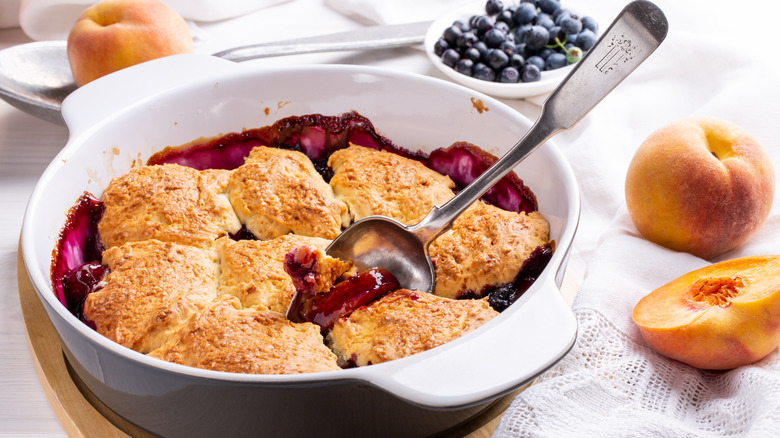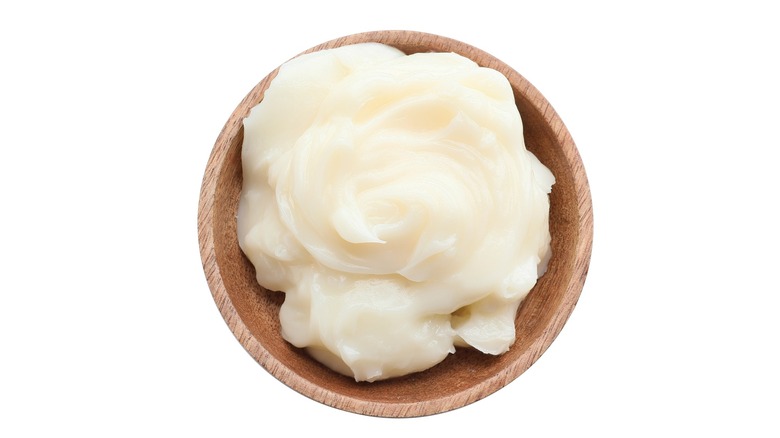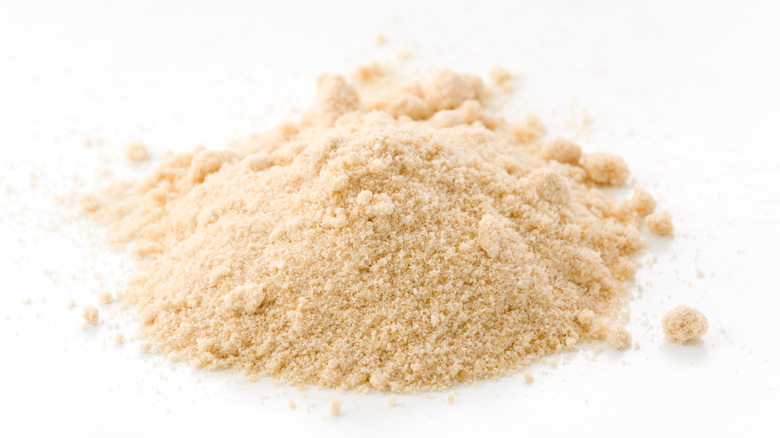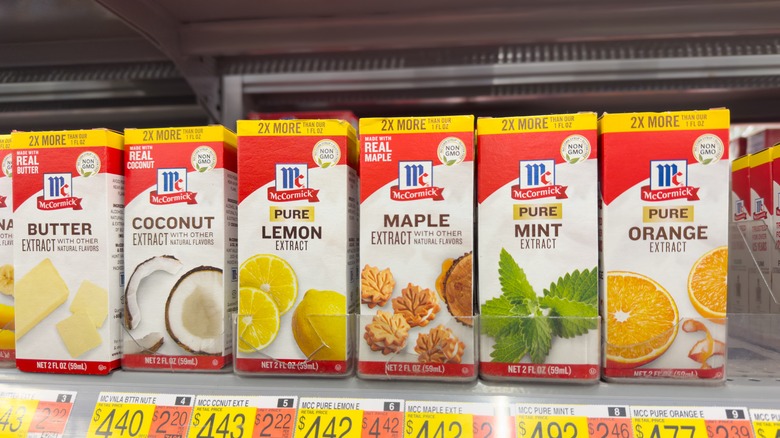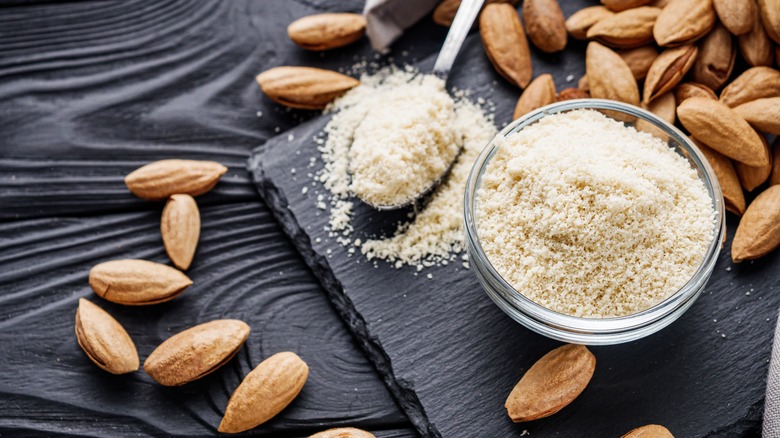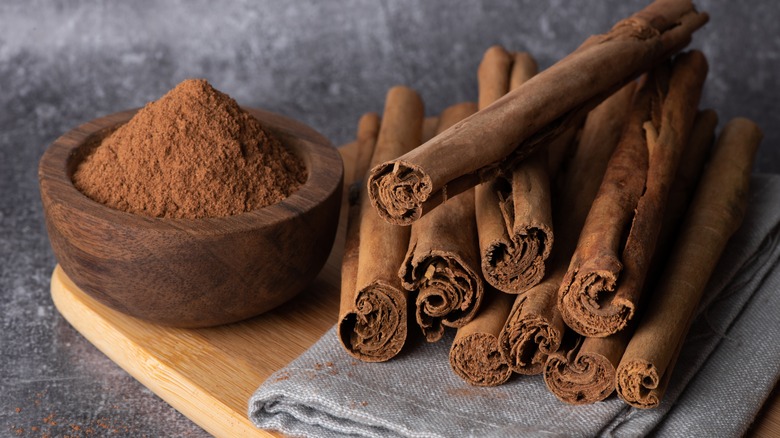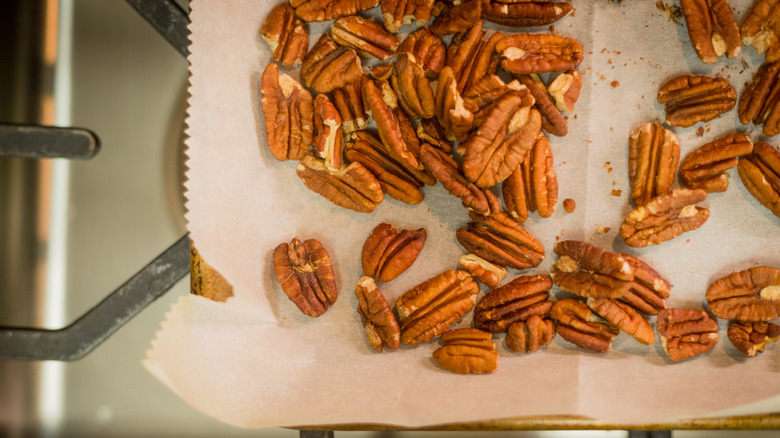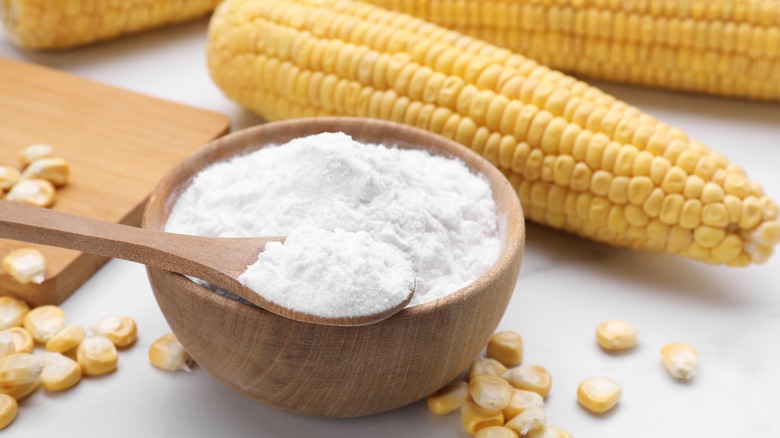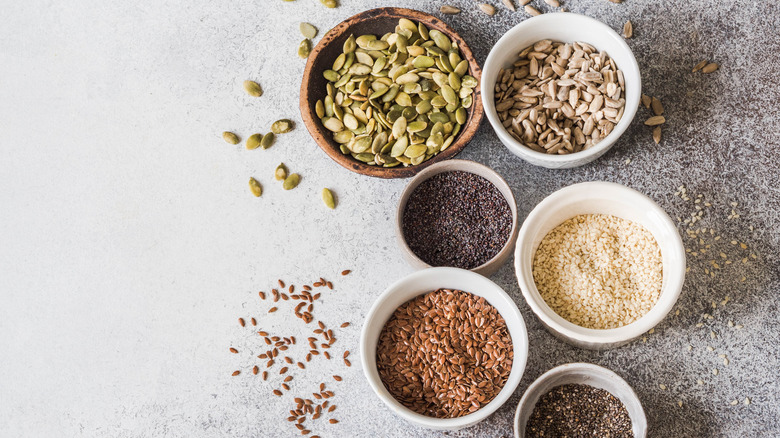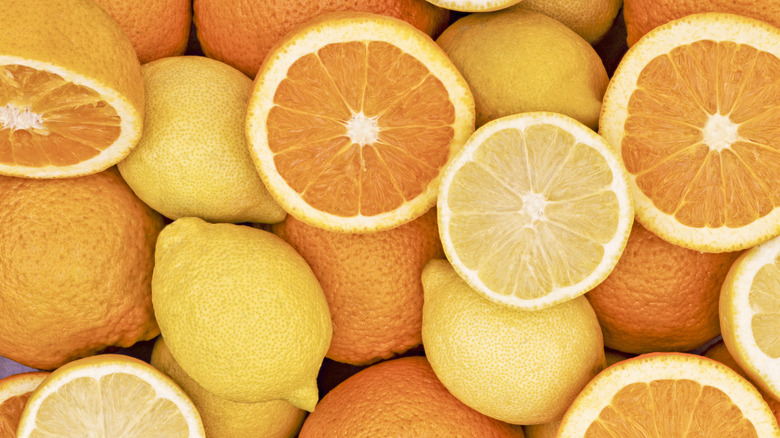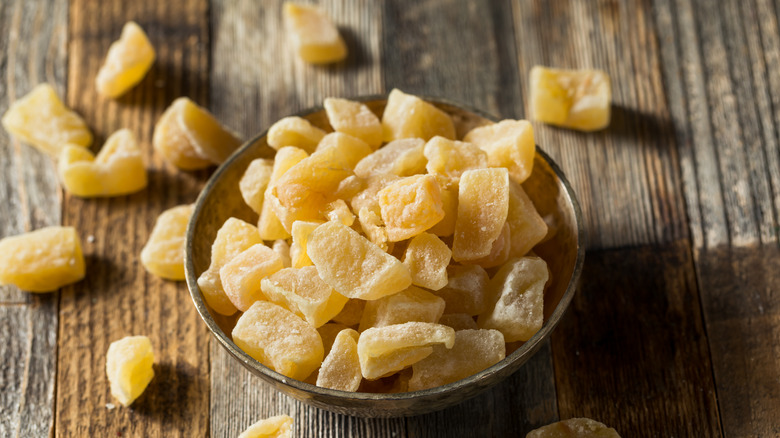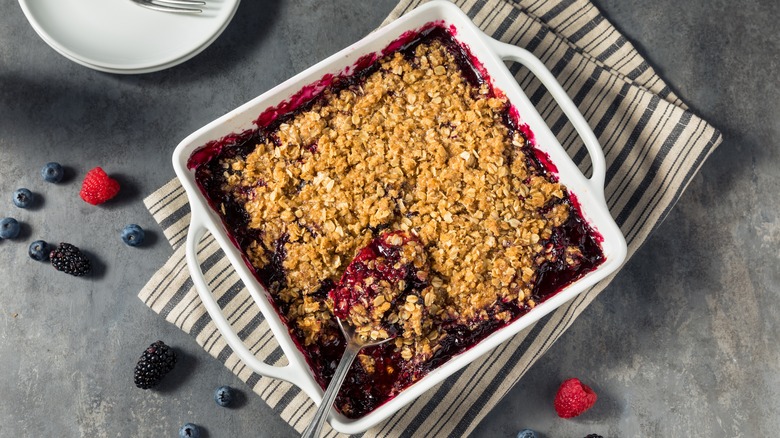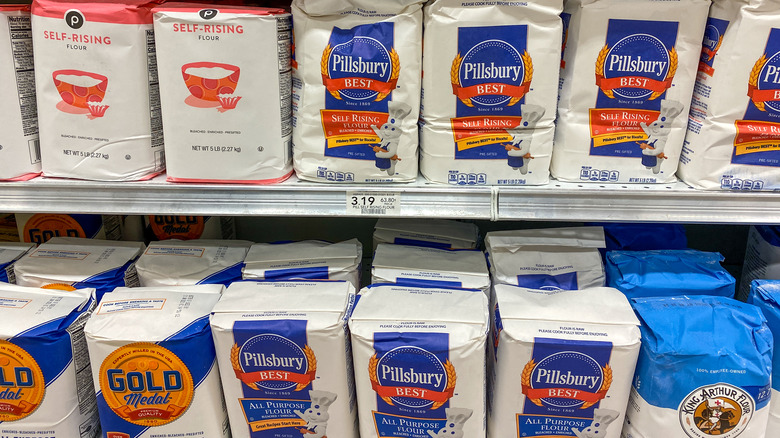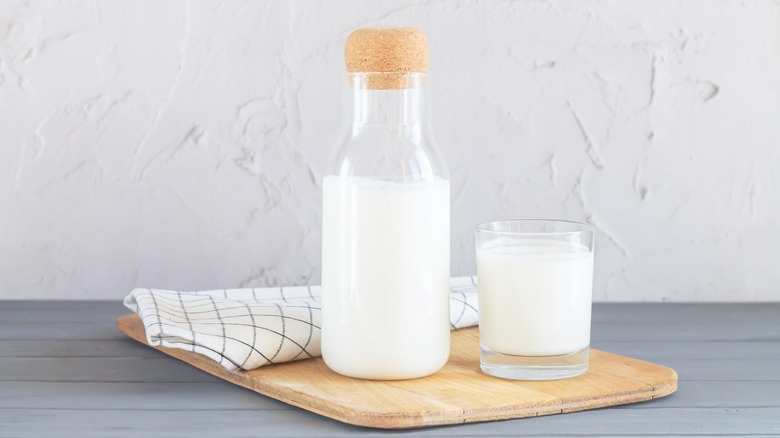13 Baker-Approved Ingredient Swaps That Will Make Your Cobblers And Crisps Taste So Much Better
Making a cobbler or crisp is the best possible way to transform fresh seasonal fruit into a magnificent dessert. These dishes are similar in many ways, so people often confuse them for each other. Both have a fruit-filled base that you can load into a baking dish or cast-iron pan. Then, you add a topping of some sort and bake them to create something that can be described as pure deliciousness. The main difference between cobblers and crisps is their toppings. Cobblers often have a biscuit or cake-y topping, while crisps have a crumbly streusel, often containing oats and nuts. While there's no shame in making the classic version of these desserts, there are a few genius swaps you can make to give them a more sophisticated flavor and improved texture. So, I'm here to give you some advice.
These sweet treats are nothing new to me since I'm a professional baker. During the span of my career, I've made too many cobblers to count. As a result, I learned some secrets on how to give them that extra oomph you might be looking for. Let me present to you 13 easy yet impactful swaps you can make for the absolute tastiest cobblers and crisps.
1. Use lard instead of butter
Lard has been around in the baking world for quite a while. In fact, it was a staple for bakers long before shortening was. However, some people seem to have forgotten its benefits, like how it can make a mean pie crust (or, in this case, cobbler topping). You might be wondering what exactly lard is. If you only bake with butter or shortening, let me introduce you: Lard is a pure animal fat that is obtained from pigs.
Despite the fact that it's an animal product, it doesn't taste like pork, but has a fairly neutral taste and smell. Lard is solid at room temperature, which makes it a top-tier replacement for butter or shortening in baking. When you use it in your cobbler topping, you don't need to adjust any of the amounts, just swap it using a 1:1 ratio. The final product will have an exceptionally rich taste with a flaky texture underneath and a crisp texture on top to balance the soft fruit in the filling.
2. Replace the granulated sugar with toasted sugar
If you've never made toasted sugar before, you'll be happy to know how easy it is to make and use. Toasting sugar is a simple way to upgrade its taste, giving it a caramel-like undertone. Its flavor is much more complex than uncooked sugar, so when you use it in desserts like cobblers and crisps, it instantly takes them to the next level. I know I said making toasted sugar is easy, but I didn't necessarily say it was quick. The process is definitely a labor of love since you have to cook it low and slow to reach the desired outcome.
However, you can do this preparation in advance and stock up on it since it lasts just as long as the un-toasted stuff. Take your sugar and spread it evenly in a glass baking dish or sheet tray. Do not spray or grease the tray because it sticks. Instead, line it with parchment paper. Cook the sugar in a 300-degree Fahrenheit oven for 30 minutes to 1 hour to start, then examine it to see if it needs longer. Make sure to stir it occasionally so that it toasts evenly. Depending on how much you make, it can take several hours. It is ready when it has an ivory to lightly golden color and fragrant smell. Then, allow it to cool and use it in your recipe as usual.
3. Try another extract besides vanilla
Vanilla extract seems to be the go-to flavor for cobblers and crisps. There's no guessing why — it pairs wonderfully with all the ingredients in the recipes, from the fruit to the spices and nuts. However, if you want to make your dessert stand out, consider adding another type of baking extract to the topping; namely, almond, coconut, rum, or maple are excellent choices. Generally, going with a warmer flavor is a good idea, but there are some cases where zesty flavors work, too, like orange extract.
When using a different product as a replacement for vanilla, you can use the same amount, so it is an easy swap. You can also play up the flavor. For example, sprinkle maple sugar over the cobbler topping when you use maple extract in the dough. Another option is to garnish the dessert with coconut whipped cream, emphasizing the flavor of the coconut extract in the topping.
4. Use almond flour for crisps
For crisps that include nuts, you can intensify the nutty taste by using almond flour in the crumb topping. Almond flour behaves a bit differently than all-purpose flour in baking since it doesn't contain gluten. In other recipes where you need gluten for structure, almond flour can cause some issues if you're not careful. However, crisp toppings are one of the best ways to utilize it since it doesn't need to rise much or have the same stability as, say, a birthday cake.
When you use it as a swap in your recipe, I recommend increasing the flour amount by 25% and seeing how the streusel mixture looks. For instance, if a recipe calls for 1 cup of all-purpose flour, use 1 ¼ cups of almond flour in its place. If you find that the crumble topping is still too wet, you can add more (or add more oats) to give it more body. You can also use almond meal, which has a slightly different consistency and taste. Because of the slight bitterness with almond meal, you might need to increase the sugar in your dessert to compensate. Almond flour is naturally sweeter, which is why it is the better option.
5. Instead of pre-ground cinnamon, use fresh
Once you experience using fresh cinnamon in your bakes, you'll never go back to using the pre-ground version again. Since cinnamon is often a forward flavor in cobblers and crisps, you'll really be able to tell the difference when you use the fresh spice. To grind your own cinnamon, you'll need cinnamon sticks and some tools to help you out; there are several methods to choose from.
First, you can use a mortar and pestle. To do so, take some cinnamon sticks and first break them up into smaller pieces with something like a meat mallet. Then, transfer them to the mortar and use the pestle to break the pieces down further, forming a powder. Be careful not to miss any large chunks. Another option is to run broken cinnamon sticks through a high-speed spice or coffee grinder. Pulse the pieces until the cinnamon powder forms.
Lastly, you can use a microplane zester, but this is a bit more time-consuming, specifically if you need a fair amount of cinnamon. I suggest using this technique when serving the dessert since you can hold it over the food and grate the cinnamon over the cobbler to add a lovely garnish.
6. Rather than raw nuts, use toasted nuts
Don't underestimate the power of toasting nuts before you use them in your crisps. Yes, you'll bake them in the oven with the filling and other ingredients, but it's not exactly the same. When you mix them with everything for the crisp topping, the surrounding streusel bits get in the way of the nuts toasting on all sides. Not to mention, the underside touching the fruit doesn't toast at all. They need that direct contact with the heat to actually develop a deeper flavor. So, before you begin your recipe, take a few minutes to toast them.
One option is to spread them in an even layer on a parchment-lined sheet tray. Bake them in an oven, preheated to 325 degrees F, until they are golden brown. You should be able to smell the toasty aroma, too. The time it takes depends on the exact nut type you use and whether you chop them beforehand, so it can range from as little as 5 minutes to over 10 minutes. Another option is to grab a skillet and heat them on the stovetop, stirring occasionally. This method might be easier for people who are short on time, as it takes only a few minutes. In fact, they can burn quickly with this approach, so be sure to use medium heat and do not leave them unattended.
7. Utilize cornstarch instead of flour in the filling
In my chef work, I've used all sorts of different thickeners for desserts. When it comes to cobblers and crisps, I've found that cornstarch is definitely the superior choice. Flour can have a starchy taste or consistency, even if you take all the proper steps to cook it. It also gives the fruit filling a whiteish color that can be off-putting. With the filling, you want the thickening agent to fully dissolve and not affect its appearance or flavor — cornstarch does just that. Moreover, it is pretty simple to work with.
To use it in your recipe, you can make a slurry by mixing it with one of the recipe's liquids. At first, it tightens, but after a few moments, it relaxes and melts into the liquid. After thoroughly mixing it, dump the mixture into the fruit filling and combine them. The slurry not only prevents clumps but also makes it easy to evenly distribute the thickener.
I've also worked with recipes where you mix the cornstarch with the sugar and spices, then toss the fruit with that mixture. I don't have any issues with that method, either, and the filling always thickens as expected. With either approach, a little goes a long way. For every 2 pounds of fruit, 1 to 2 tablespoons of cornstarch is usually sufficient, but you might need more or less depending on the exact fruit you use and how juicy it is.
8. Replace some nuts with seeds
Many different seeds are suitable for desserts because of their tastes and texture, and they are especially delicious in crisps that already have nuts. The seeds can provide a crunchy texture, earthy taste, and even extra vitamins and nutrients to the dessert. Most seeds are high in protein, B vitamins, and numerous minerals, like magnesium, zinc, and iron. If your recipe calls for nuts, you can substitute 25% of them with your preferred seeds.
Some excellent types for a crisp are pepitas, sesame seeds, or sunflower seeds. All of these options are already small, so you don't have to chop them. Pepitas have a naturally sweet undertone that is a good match for spices and fruit. Meanwhile, sesame seeds are exceptionally crunchy. They are tiny and almost have an almondy taste when you bake them, making them perfect for a crisp. Lastly, sunflower seeds are more tender in comparison and taste nutty, making them a great candidate as well. If you can't choose just one, you can make a blend of all three.
9. Use orange juice instead of lemon for more sweetness
Both lemon and orange juice can benefit a fruity dessert. When used correctly, their citrusy taste brings out the best qualities in fruits like peaches, apples, or berries, all of which are common choices for cobblers. Yet, one thing to consider is whether you prefer your baked goods to be primarily sweet or have more tart qualities. Some might not realize the impact that fresh lemon juice can make. Remember that some fruits are naturally more astringent, so if you add lemon juice to the filling, it can heighten that tart taste.
While orange juice has a certain level of zestiness, its natural sugars offset it. For people who want their desserts to be on the sweeter side, orange juice is the best option. You can count on it making the dessert brighter and more refreshing without having to worry if it will make it too acidic for your liking.
10. Swap dried ginger for crystallized ginger
Some cobbler and crisp recipes call for assorted spices, like ginger. If this is the case for yours, you can swap the dried ginger for the crystallized kind (or simply add it to your recipe as an additional ingredient). Crystallized ginger is made by coating root ginger's surface with sugar, and is unique because it's sweet, spicy, and chewy all at once. It awakens your taste buds while supplying a nice bite with its gummy texture. Furthermore, it tastes incredible with peaches, blackberries, apples, or blueberries, so if your cobbler features these fruits, you're in luck.
The neat thing about this ingredient is that you can use it in either the biscuit dough, streusel, or the fruit filling by adding it last and folding it in. Because of its sharp taste, you only need 2 to 4 tablespoons per dish. Another word of advice: Don't just throw large chunks of candied ginger into the dessert. You must chop the pieces finely, otherwise, it can feel leathery and tough to chew. Dicing it small is definitely the way to go. You might even be able to purchase it pre-chopped to save on prep time.
11. Sub a portion of the primary fruit for another type
Sure, a homemade apple crisp or a peach cobbler is delicious, but what's the harm in using more than one type of fruit or berry? You don't have to go all out and use five different types, but at least consider swapping a small amount of the primary fruit with another kind that is complementary. For instance, if you plan to make a blueberry crisp, you can try using 75% blueberries and 25% huckleberries. Blueberries are quite sweet on their own and can benefit from the tart huckleberries. Or, instead of a regular old apple crisp, add a smidge of cranberries to give it a puckery kick while also adding color to the dish.
When using more than one type of fruit, there is one thing to keep in mind: their cooking times. If one of them takes significantly longer to cook than the other, you can give it a jump start by partially cooking it on the stovetop first, leaving out the softer fruit. Allow it to slightly cool before you fold in the more delicate fruit, transfer the filling to a baking dish, and cover it with the topping. This way, when you bake it, you don't end up with a disappointing, soggy dessert.
12. Replace all-purpose flour with self-rising flour in cobblers
For desserts with a biscuit-like dough, like a blackberry cobbler recipe, you can utilize self-rising flour in place of all-purpose flour. This product is convenient because it already has baking powder and salt evenly dispersed throughout it. Therefore, it can be a time saver when measuring the ingredients for the recipe. Self-rising flour also has less protein content than all-purpose flour, which means it produces very tender and fluffy baked goods.
Not every recipe is ideal for this flour type, like recipes that use yeast or baking soda. Nevertheless, it's excellent for cobbler toppings since they usually call for baking powder anyway. Just remember to omit the salt and leavening agent in your recipe when you use it. You'll certainly be happy with the end result because the cobbler topping will rise nicely and become impressively fluffy rather than being tough or dense.
13. Use buttermilk in place of whole milk
If your cobbler topping requires milk in the batter, try using buttermilk instead, like with this cardamom peach cobbler. Buttermilk is thicker than milk and has a tangy undertone, which can help balance the sweet, fruity filling. And don't worry, it isn't so sour that it overpowers the dessert. Traditional buttermilk is a byproduct of the butter-making process. However, it can also be made it by introducing live cultures of good bacteria (lactic acid) to milk. Because of its unique taste and consistency, bakers use it in various recipes like scones, biscuits, pound cakes, or muffins.
For cobbler dough or batter, you can use the same amount as you would whole milk. It might make the dough a bit thicker, but that texture change won't be noticeable once it bakes. Instead, the crumb will have a richer, more complex taste. Also, if you don't have buttermilk on hand, you can create a makeshift version. For every cup of milk, add 1 tablespoon of white vinegar or lemon juice. Allow it to sit for a few minutes until it becomes slightly lumpy. Then, it is ready to be used in your recipe.
